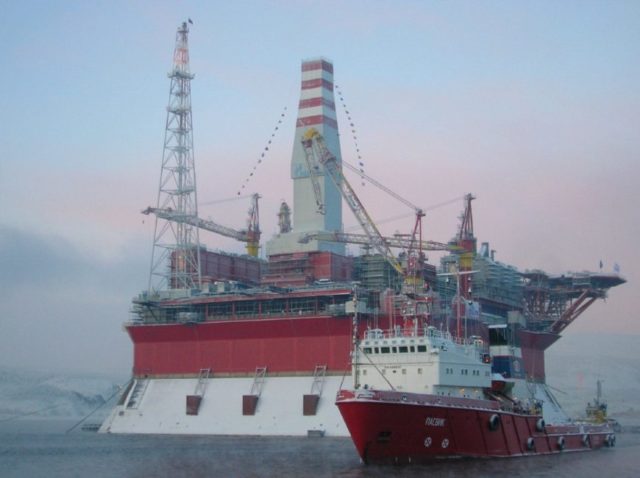
The Bloom Comes off the Arctic Rose
Publication: Eurasia Daily Monitor Volume: 14 Issue: 96
By:

For about a decade, the Arctic has been a showpiece of Russian policy. And with the Vladimir Putin regime’s displayed proclivity for engaging in vast “mega-projects” like the Sochi Olympics, the Arctic had been in a class of its own as a multi-year economic and military showcase. However, the bloom is now off that rose. Since May 2017, it has become clear that the government program for the Arctic, which is overseen by the Ministry of Economic Development, would be slashed. In January, the ministry requested 209 billion rubles ($3.5 billion) for implementing the Arctic development program through 2020. This program would have entailed a new class of nuclear-powered icebreakers, the Lider, and a fleet of vessels for Arctic environmental protection and shelf research. As much as 80 billion rubles ($1.4 billion) was to be spent on the Lider alone. But that allocation has since then been cut twice, and total Arctic spending will now reportedly amount to 12 billion rubles ($200 million) (RBC, June 30).
More than half of the new funding will go to designing and building an ice-resistant drifting platform “North Pole” for Roshydromet (Russian Hydro-Meteorological Association, which is controlled by the Ministry of Natural Resources and Environment). Other key program include rehabilitating the Zhataisk Shipyard in Yakutia, and a billion rubles ($20 million) will go to the National Guard to carry out anti-terrorist activities in the Russian High North. But the Ministry of Defense will continue to make the Arctic a priority. It plans to spend 34 billion rubles (about $570 million) on military projects in this region (RBC, June 30).
These decisions followed a government summit, last April, in Murmansk, where Prime Minister Dmitry Medvedev declared that the funding for this northern city’s port was insufficient. Despite the importance the Russian government attributed to diverting some shipping traffic away from Baltic ports to the Arctic, it turned out at this meeting that there is a shortage of state funds to allocate to this project (Government.ru, April 21). Consequently, the authorities are now trying to encourage private transport and energy firms to bail it out and make up the investment needed to bring the entire government program for transportation to and through the Arctic to fruition (Iz.ru, July 16).
These setbacks are likely a bitter blow to the Kremlin. After all, in March, President Putin visited the Russian High North and insisted that the government speed up its development on the basis of the 2020 socio-economic program for the region (Kremlin.ru, March 30). Even though traffic through Arctic ports, including Murmansk, increased in 2016, it is clear that the Russian government cannot afford to keep pouring money into the region through 2020. Nevertheless, Moscow continues to insist on attempting to implement its military program in the country’s northernmost territories (Realnoe Vremya, January 31).
The impact of international sanctions and chronically low energy prices are wreaking havoc upon the Russian economy and the state’s big-ticket items like the Arctic. These outcomes underscore the weaknesses and inherent risks in these mega-projects and Putin’s grandiose vision of the High North that he and the government clearly see as a treasure-trove of natural resources (Kremlin.ru, March 30), despite weak market interest in those goods at present and the enormous cost of extracting them (see EDM, April 29, 2016; March 29, 2017). In view of the spiraling costs of the multiple transport and infrastructure projects in the Arctic, amid the storm of accumulating socio-economic crises that have triggered much more visible discontent than in the past (see EDM, March 30, May 12), and considering the impending election campaign, the government has had no choice but to slash Arctic spending. Likewise, it has had to reduce defense spending, even though the latter continues at a high rate through 2025. But none of that has evidently forced the topmost leadership to reconsider the idea that Russia’s economic future lies with increasing energy extraction from the Arctic.
Therefore, one may surmise that the government envisions this reduction of outlays for the Arctic as more of a temporary retreat. The presumption in Moscow appears to be that the Arctic will eventually become the main source of a grandiose future tied to energy and mineral extraction rather than, at most, a modest contribution to Russian prosperity and development. And this natural resource that Russia depends on is itself at considerable risk from climate change—a danger that will entail massive additional costs to avert.
The cutbacks in spending within weeks of the Kremlin’s insistence on completing the existing program despite rising costs and budgetary shortages also seems to indicate Putin’s own lack of accurate information and understanding of Russian realities. Either the Russian president is uninformed, or he is not being properly briefed on the situation until it becomes impossible to deal with the reality in a timely and effective manner. The expenses and risks involved in undertaking a dramatic expansion of the military presence in the Arctic and its energy while simultaneously developing the region’s transport and energy infrastructure are profound. Therefore, the government’s ability to formulate and implement an economic program based on an appreciation of existing realities is rather limited. Though few have commented on this point, obstacles in developing the Arctic become another marker for what could become further stagnation and a deeper crisis in Russia for years to come.



